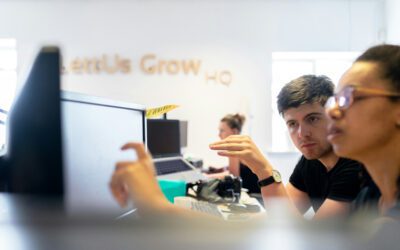Most manufacturers are familiar with the widening ‘skills gap.’ This is a multifaceted issue that includes Baby Boomer and Gen X generations retiring, lack of focused professional development and sufficient on-the-job training, and lost opportunities to capture intellectual and institutional knowledge among other things.
OMEP has been hearing from manufacturers having trouble securing applicants for job openings, as well as those that hire new employees only to have the new hires be a no-show on their first day or leave shortly thereafter. We’re seeing unprecedented turnover across sectors and this situation prompts business leaders to ask important questions:
-
How can we best capture the knowledge of our retiring workforce before they leave?
-
How can we transfer this information efficiently and effectively to ensure the development of knowledge and proficiency?
-
What can we do differently to create a positive and self-motivating environment to engage and retain talent?
Consider the following:
Take Time to Better Understand the Generation Entering the Workforce
Gen Z is the most diverse generation in history, and they have an entirely unique perspective on careers and how success in life and work are defined. They are about evenly split on what’s more important – better pay or an interesting job. They want to work for an employer that is a good global citizen that demonstrates a commitment to societal challenges such as sustainability, climate change, hunger and homelessness, and inequality.
Both groups are leery of anything that is not authentic. They do not want lip service. They like to see companies taking real action toward meaningful change. Manufacturers might explore benefits that align with interests in global citizenship such as time off to volunteer, matching funds for their donations, team building activities in support of a non-profit or societal cause, company initiatives that give back to the community and/or reduce waste, and activities that positively impact the environment among others.
If you are a leading-edge business working to address some of these issues, are you promoting your initiatives and values in your job descriptions, website and other materials?
Consider Your Brand and How it Appears to Job Seekers in a Job Search
In today’s digital world, job seekers have easy access to information about your company. If you haven’t refreshed your LinkedIn or Facebook pages in a long time, consider an update. Serious job seekers often thoroughly research a business before applying. They want to ensure that a job is worth their time – that the business aligns with their values and is a good fit. The more information you can share about your culture, workplace, benefits and work style, the better.
Ensure your website offers current and accurate information. Your website does not have to be flashy, but a simple design with relevant information is essential to making a good first impression. If you are hiring, consider asking existing employees to create a blog post or page about why they enjoy working for your company. Engage with your existing employees to help potential new employees better understand your culture.
Use free tools at your disposal, such as your Google Business profile and Glassdoor to showcase your business.
Review Job Descriptions and Prioritize Requirements
Gen Z have experienced massive periods of economic stability and been told that obtaining a college degree was an insurance policy against poverty. However, more than half of Gen Z college graduates said their expensive college education didn’t make them career-ready. While 72% of the roles today have lower requirements than just six months ago, 3 in 5 employers admit that they are favoring college graduates over qualified middle-skill candidates with relevant experience.
Review applicant resumes from a more open and broad perspective, looking for not only education and specific experience, but also for potential and transferrable skills and desired behavioral attributes. Identify more qualifications as ‘nice to have’ rather than ‘required’ and be explicit about what the company will train.
Create and Maintain Solid Onboarding, Training and Upskilling Solutions
About 4 in 10 of the Gen Z generation are not following the traditional college route and are entering the workforce directly after leaving high school. And, 86% of non-college graduates expect a promotion or a transfer to a new job opportunity in less than a year from starting at entry-level.
Define development plans and career paths and communicate during and after the hiring process. Paint a picture for your incoming employees of the pathway they can take within your company to increase skills and, therefore, earning power. Limit compensation based on longevity with the company. Instead, base it on skills and knowledge earned. Be upfront about that pathway, allowing for some flexibility and articulate what’s in it for the job seeker/employee.
If promotions or new positions aren’t an option, companies can still strive to understand what motivates each employee and be ready to offer challenging or new projects and growth opportunities.
Create a Culture of Problem Solvers
Transparency of KPIs (key performance indicators) and participation from all employees is key to reaching goals. Engage employees by helping them to see how their job relates to the big picture. Create a reward and feedback system that welcomes new ideas. In doing so, you foster a sense of community and encourage employees to be part of the collaborative effort to grow and improve. Ultimately, psychology tells us that the pursuit of a lofty goal is closely tied with fulfillment and happiness (whether inside or outside of a job).
Capture Institutional Knowledge and Make it Readily Available
OMEP has support available for those who would like to utilize technology to build and maintain work instructions, job training modules, and more. This ensures that you capture knowledge from employees and disseminate it in a tangible way so that it does more than sit on the shelf.
OMEP has been working with Novunex to modify and custom-build their application, and it is an operational excellence management system that has a Document Control (QMS) element. It also has a standard work instructions builder, a learning management system to deploy training (document, classroom, and on-the-job), a continuous improvement tracker (ideas, tasks, projects), and more. If you’re interested in learning more, reach out.
At the heart of the issue, employee retention is tied to employee engagement. Identifying and articulating your company values, and creating a positive work climate that empowers employees to live those values, will improve retention.
Do you want help creating career paths? Looking for OMEP’s support in hiring, training, or applying technology to your workforce challenges? We’re here to help >
Note: While there are some generally defined characteristics of the various generations, it’s important to keep in mind that the characteristics aren’t 100% applicable to everyone within the generational group. There are many other factors to consider, but it’s good to have a basic understanding and then work with all employees to understand what’s important to each of them.
SOURCES:
https://www.shrm.org/
https://hiring.monster.com/employer-resources/blog/labor-statistics/new-grad-survey/
https://www.techrepublic.com/article/the-great-resignation-of-2021-are-30-of-workers-really-going-to-quit/
https://www.marketwatch.com/story/half-of-young-americans-say-college-isnt-necessary-2019-08-06
https://www.hbs.edu/news/releases/Pages/degree-inflation-us-competetiveness.aspx



